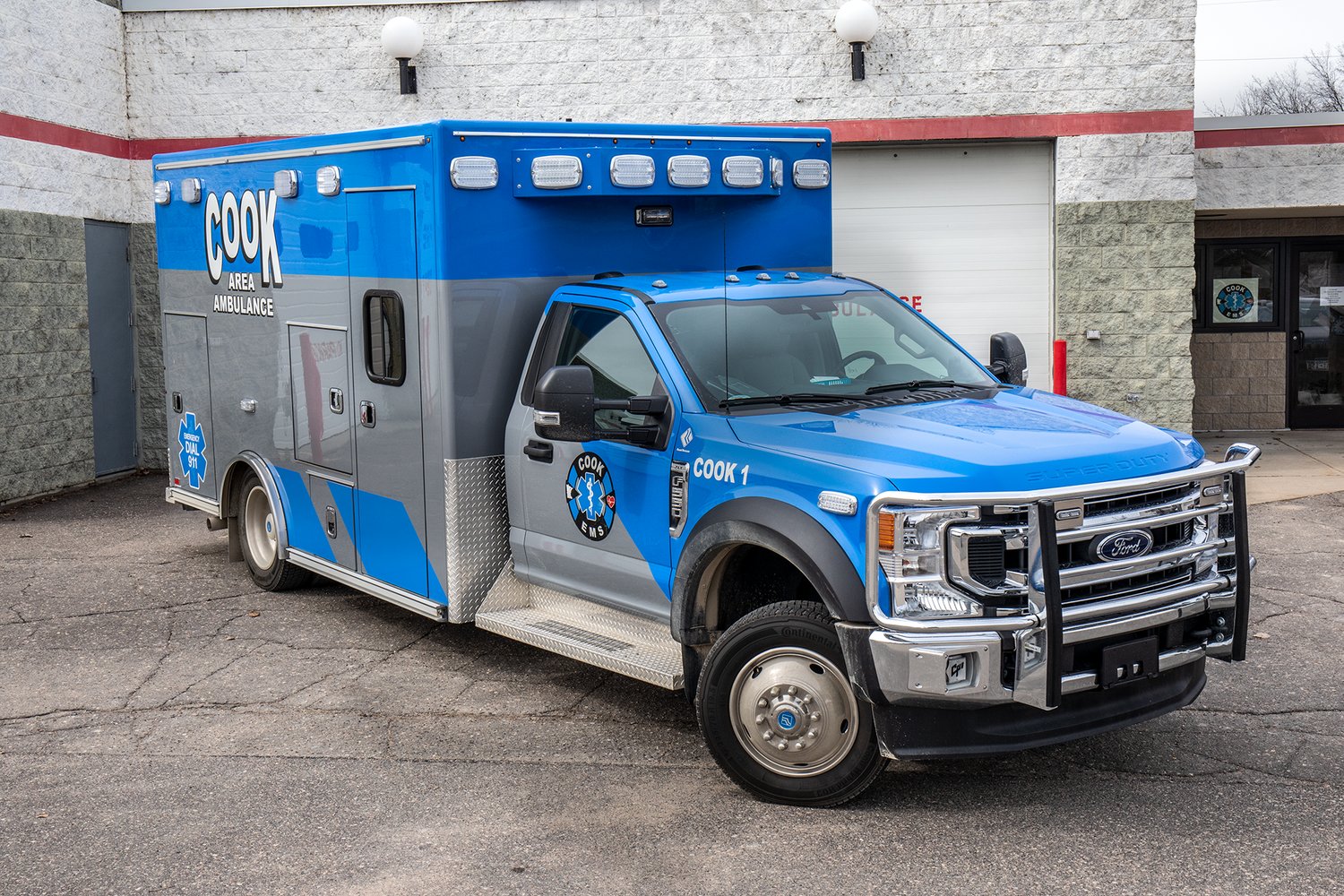Support the Timberjay by making a donation.
New Cook ambulance is truly one of a kind
EMT spearheads customization effort for added safety and service
COOK- If EMT Justin Bachman looks a little prouder than the rest of his Cook Ambulance crewmates about the shining new blue-and-gray ambulance the department recently received, there’s a good …
This item is available in full to subscribers.
Attention subscribers
To continue reading, you will need to either log in to your subscriber account, below, or purchase a new subscription.
Please log in to continue |
New Cook ambulance is truly one of a kind
EMT spearheads customization effort for added safety and service
COOK- If EMT Justin Bachman looks a little prouder than the rest of his Cook Ambulance crewmates about the shining new blue-and-gray ambulance the department recently received, there’s a good reason why. Bachman took the lead in designing the rig’s color scheme and new logo, and more importantly, customizing the interior with features designed to improve safety and patient care.
Bachman has been with the service since 2017, and he’s still not quite certain how he ended up overseeing the design process.
“I wish I could tell you the exact story, but I don’t know,” he said. “I was like, ‘I’m ready to go, what are we waiting for? Here’s my ideas.’ It kind of just snowballed from there. And now we have a brand-new ambulance.”
The crew was particularly eager to receive the new unit because last March one of their two rigs slid through an icy intersection and into a ditch. Two crew members were injured, and the ambulance was totaled. The service ran just one ambulance until an older 2011 model was found to replace it while they waited for the new ambulance to arrive.
“We were told it would take about 12 to 14 months when we ordered it, so we knew it would be between November and January,” ambulance director Tina Rothleutner said. “Then we were told it was supposed to come in December, then January, then it got pushed out to February. It finally got pushed out to us the beginning of March.”
Folks used to seeing the familiar white with blue-and-red accents unit will notice a stark difference immediately with the sharp blue-and-gray motif. The gray was an automobile color Bachman liked, and the blue was a perfect complement, he said. Crew members agreed with the switch because white was just too hard to keep clean.
“One of the big comments from all of us was that white shows the bugs,” Bachman said. “We want to look professional.”
The ambulance is based on a Ford F150 chassis, has four-wheel drive, and has the safety advantage of having lower entry points that the van-based model, making it easier and less hazardous to get in and out.
But the real game-changers are inside, changes Bachman spent a great deal of time researching. He got feedback from his teammates and consulted colleagues with Ely Ambulance about their rigs. He scoured numerous manufacturers’ websites and contacted dealers directly, and more, looking for ideas, always with an eye on safety and patient care improvements.
“That was a big thing for us, safety for everybody involved from the patient to the EMTs and the medics, whoever’s in the back,” Bachman said.
Four-point harnesses are used for seating restraints, and in the cab a driver can monitor a camera feed of the main compartment, improving awareness and communication if a change is needed for patient care.
Instead of a bench for EMTs to sit on beside a patient, Bachman chose a track seat for the main patient caregiver.
“They’re able to slide up and down a track on a seat while maintaining safety by being belted in,” Bachman said.
Storage elements were designed so that materials in the new rig can be stowed, for the most part, in the same locations as the other rig.
“The last thing you want to do in a stressful situation is forget where something is,” Bachman said.
A unique feature of the upper cabinets is that the fronts are slanted, rather than boxy. It’s a small thing, but it creates a better work environment.
“It has more of an open feel versus a box, a little more head space,” Bachman said. “You’re able to move around and have a good visual and not have it feel claustrophobic.”
A power load system eliminates the hazards associated with lifting patients into the ambulance. EMTs mainly just have to watch and guide the patient as the cot is loaded. The large, heavy oxygen bottle that often would have been lifted in and out of another rig is also is on a specialized loading rack that eliminates that physical stress.
The list of modifications is longer still, but Bachman, who hasn’t yet taken it out on an actual run, believes that in total the customized design is mission accomplished.
“The whole experience came out real nice,” he said.
But that doesn’t mean the rig has been sitting idle. Right after it arrived, the other unit suffered a blown tire that in turn caused a ruptured brake line, putting it out of service for repairs.
“The weekend of March 12 we had six or seven calls, so it got used on every one of them,” Rothleutner said.
And how were the reviews?
“So far everyone has liked it a lot,” she said. “There’s been a couple of little ‘Can I suggest we do this’ and ‘Can we change this’ type of things.”
Rothleutner has a crew of about 22 to staff the ambulance schedule, but the service could still use more help. For people interested in being trained as an EMR or EMT, Rothleutner said Cook Ambulance will pay for the training in exchange for a contractual commitment by the trainee to work for the ambulance for a specified period of time.









